Dependent drop down list in Excel is a dynamic tool that significantly enhances data entry efficiency and accuracy by linking lists and ensuring that the choices in one drop down are relevant to the selection in another. Perfect for cascading selections like country and city or product category and items, this feature streamlines workflows and minimizes errors. In this guide, we explore the steps to create dependent drop down list in Excel, enabling you to construct interactive, user-friendly spreadsheets that respond intelligently to user input, ensuring data consistency and precision in your reports and forms.
The dependent drop down displays values in a drop-down list based on the value selected in another drop-down. This makes it simple for users to enter the data that is required. Drop down lists are used to validate data in a unique way.
First, take a sample list of Continents and some of its Counties as per below list:
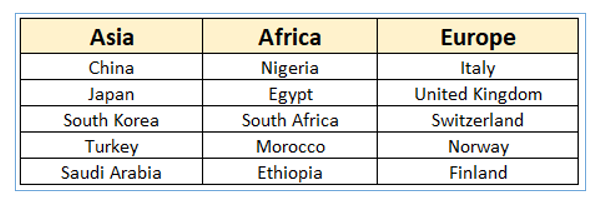
Steps of creating a Dependent Drop-Down List in Excel:
Step-1: Select the cell where you want the first (main drop) Excel drop down list to appear.
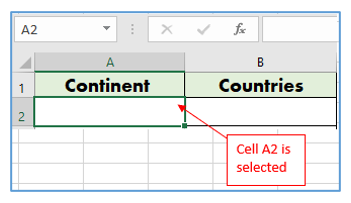
Step-2: Navigate to Data. Then tap on the Data Validation. The data validation dialog box will appear.

Step-3: Select List on the data validation dialog box’s settings tab (data validation list).
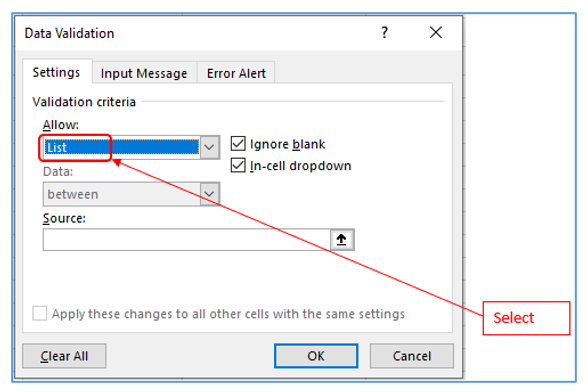
Step-4: In the Source area, enter the range that contains the items to be displayed in the first drop down list.
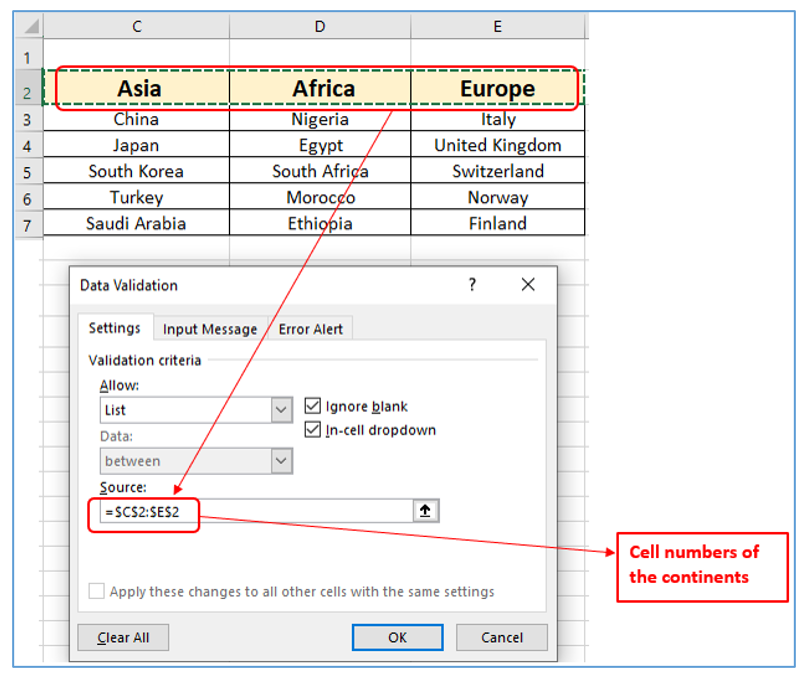
Step-5: Select OK. This will result in the creation of the Drop Down 1. The main drop down list is created.
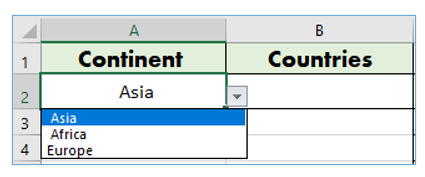
Step-6: You must build named ranges for dependent drop-down lists. Select the entire data set. Navigate to Formulas -> Defined Names -> Create from selection. Here we make a dependent list.
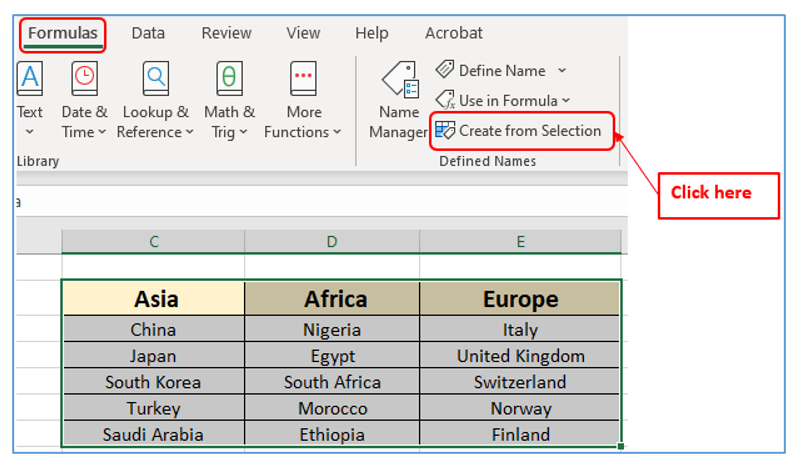
Step-7: A pop-up will appear. Select “Top Row” and then click OK.
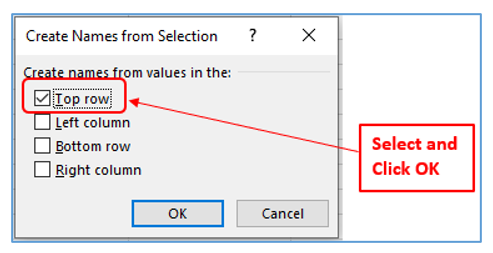
Step-8: Choose the cell where you want the Dependent/Conditional Drop-Down (second drop-down) list to appear.

Step-9: Navigate to Data. Then tap on the Data Validation. The data validation dialog box will appear.

Step-10: Select List on the data validation dialog box’s settings tab.
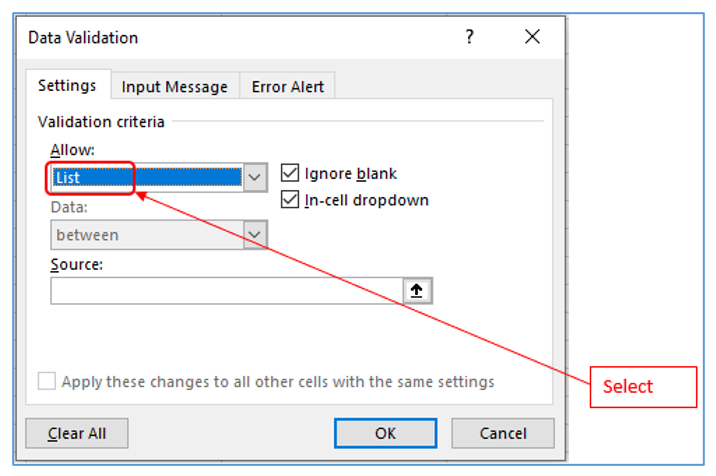
Step-11: Enter the following formula in “Source” and click OK.
=INDIRECT(A2)
(A2 is the cell that holds the main drop-down menu.)
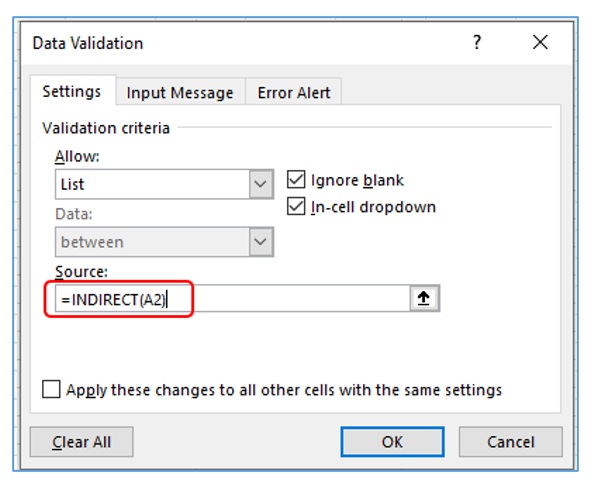
Result outlined below:
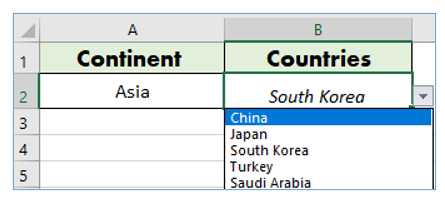
Choose Europe from the Continent list, in the Countries drop you see the relevant countries.
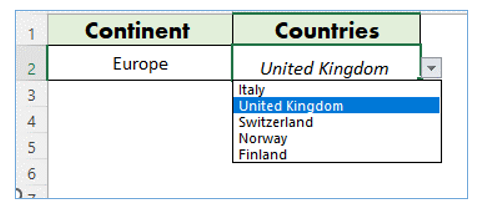
Create multiple dependent drop down list in Excel
Creating multiple dependent drop-down lists in Excel involves setting up lists where the options in one drop-down list depend on the selection made in another. Here are key points to guide you through creating these dependent lists:
- Define Your Data:
- Start by organizing the data you want to appear in your drop-down lists. Group related items together, typically in separate columns or sheets, which makes it easier to reference them later.
- Create Named Ranges:
- For each group of related items, create a named range. This can be done by selecting the cells containing the data, then typing a name into the name box (left of the formula bar). Names must be unique and should ideally be without spaces (use underscores if needed).
- Create the First Drop-down List:
- Select the cell where you want the first (primary) drop-down list.
- Go to the Data tab, click ‘Data Validation’, and choose ‘Data Validation’.
- In the settings tab, select ‘List’ from the Allow box, and either type in the range manually or select it directly from the worksheet.
- Use INDIRECT Function for Dependent Lists:
- For the dependent drop-down list, you will use the INDIRECT function to reference the named ranges.
- Select the cell for the dependent drop-down. Go to ‘Data Validation’ again.
- In the Source box, type
=INDIRECT(cell reference), where “cell reference” refers to the cell of the first drop-down. This formula uses the selection of the first drop-down to determine which named range to display as options in the dependent drop-down.
- Expand Dependencies (if more than two levels):
- If you have more than two levels of dependencies, repeat the previous step for each new level of dependency. Make sure each level’s input range is named appropriately, and its drop-down list points to the output of the previous list using the INDIRECT function.
- Testing and Validation:
- Test each drop-down list by selecting different options in the primary list and ensuring that the dependent lists correctly update to reflect the available choices based on the primary selection.
- Ensure that all ranges are correctly named and that no errors occur in the references.
- Error Handling:
- Consider what should happen if a selected item in the first drop-down does not have corresponding items in the next level. You might need to use error handling in your formulas (e.g., IFERROR with INDIRECT) to manage these situations gracefully.
- Enhance Usability:
- Add instructions or labels to your Excel sheet to guide users on how to use the drop-down lists. Ensure that the sheet is user-friendly and intuitive.
Application of Dependent Drop Down List in Excel
Here are some uses of Dependent Dropdown Lists:
- Dynamic Forms and Surveys:
- Create interactive forms or surveys where the options in one question depend on the responses to a previous question, ensuring relevance and streamlining the data collection process.
- Inventory Management:
- Manage inventory by selecting a category (e.g., electronics) in the first dropdown and showing only related items (e.g., laptops, cameras) in the dependent dropdown, improving the efficiency of stock handling.
- Order and Invoice Processing:
- Streamline order and invoice forms by allowing users to select a main product category and then choose specific products or services from a refined list, reducing entry errors and processing time.
- Resource Allocation and Scheduling:
- Allocate resources or schedule events based on a hierarchy of choices, such as choosing a department first and then selecting available team members or timeslots in the dependent dropdown.
- Website Navigation:
- Enhance website navigation by providing a cleaner interface where users select a main category (e.g., services) and then navigate through more specific options (e.g., consultation types), improving user experience.
- Data Entry Consistency:
- Ensure consistency in data entry by limiting the choices available based on previous selections, reducing the likelihood of incompatible or incorrect data entries.
- Customer Relationship Management (CRM):
- In CRM systems, use dependent dropdowns to select customer names and then display related information such as account numbers or recent orders, making customer management more efficient.
- Educational Tools and Quizzes:
- Create educational tools or quizzes where the selection of a topic in the first dropdown determines the subset of questions or materials available in the second dropdown, providing a tailored learning experience.
Dependent Dropdown Lists are highly effective for ensuring data integrity, improving user experience, and streamlining processes in various applications where hierarchical or conditional data selection is required.
Dependent Dropdown List in Microsoft Excel concludes your journey towards creating highly interactive and user-friendly spreadsheets. Mastering this powerful feature not only elevates the efficiency of your data entry but also significantly enhances the accuracy and reliability of your data analysis. As you integrate dependent dropdown lists into your Excel toolkit, you unlock a new realm of possibilities, ensuring that your spreadsheets are not just tools for data storage, but dynamic platforms for insightful data interaction. Embrace the full potential of dependent dropdown lists in Excel and transform your spreadsheets into sophisticated, responsive, and intelligent data management solutions.
For ready-to-use Dashboard Templates:
